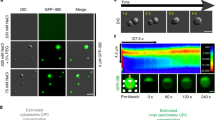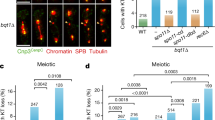Abstract
The dicentric and multicentric chromosomes in L cells and a brain tumor cell line of mouse display only one site of kinetochore formation associated with the ‘active’ centromere. The accessory or ‘inactive’ centromeres show premature separation. These cell lines were treated with 10−6 M 5-bromodeoxyuridine (BrdUrd) followed by anti-BrdUrd antibody to study the pattern of replication of pericentric heterochromatin flanking the active vs inactive centromeres. Regardless of its quantity, heterochromatin around the inactive centromere replicates earlier than that associated with the active centromere. There appears to be a relationship between the timing of separation of a centromere and the timing of replication of pericentric heterochromatin. The premature replication of heterochromatin associated with an inactive centromere may be responsible for its premature separation and, hence, inactivity.
Similar content being viewed by others
References
Brenner SL, Pepper D, Berns MW, Tan E, Brinkley BR (1981) Kinetochore structure, duplication and distribution in mammalian cells: analysis by human autoantibodies from scleroderma patients. J Cell Biol 91:95–102
Brinkley BR, Valdivia MM, Tousson A, Brenner SL (1984) Compound kinetochores of Indian muntjac: evolution by linear fusion of unit kinetochores. Chromosoma 91:1–11
Brinkley BR, Tousson A, Valdivia MM (1985) The kinetochores of mammalian chromosomes: structure and function in normal mitosis. In: Dellarco V, Voytek PE, Hollaender A (eds) Aneuploidy — Etiology and mechanisms. Plenum, New York, pp 243–256
Brown SDM, Dover GA (1980) The specific organization of satellite DNA sequences on the X-chromosome of Mus musculus: partial independence of chromosome evolution. Nucleic Acids Res 8:781–792
Earnshaw WC, Migeon BR (1985) Three related centromere proteins are absent from the inactive centromere of a stable isodicentric chromosome. Chromosoma 92:290–296
Fitzgerald PH, Pickering AF, Mercer JM, Miethke PM (1975) Premature centromere division: a mechanism of nondisjunction causing X-chromosome aneuploidy in somatic cells of man. Ann Hum Genet 38:417–428
Hilwig I, Gropp A (1973) Decondensation of constitutive heterochromatin in L cell chromosomes by bis-benzimidozole compound (‘Hoechst 33258’). Exp Cell Res 81:474–477
Horz W, Altenburger H (1981) Nucleotide sequence of mouse satellite DNA. Nucleic Acids Res 9:683–696
Lau YF, Hsu TC (1977) Variable modes of Robertsonian fusions. Cytogenet Cell Genet 19:231–235
Lica LM, Narayanswami S, Hamkalo BA (1986) Mouse satellite DNA, centromere structure and sister chromatid pairing. J Cell Biol 103:1145–1151
Lima-de-Faria A (1983) Molecular evolution and organization of the chromosome. Elsevier/North Holland, Amsterdam
Merry DE, Pathak S, Hsu TC, Brinkley BR (1985) Antikinetochore antibodies: use as a probe for inactive centromeres. Am J Hum Genet 37:425–430
Pietras DF, Bennett KL, Siracusa LD, Woodworth-Gutai M, Chapman VM, Gross KW, Kane-Hass C, Hastie ND (1983) Construction of small Mus musculus repetitive DNA library: identification of a new satellite sequence in Mus musculus. Nucleic Acids Res 11:6965–6983
Rattner JB, Lin CC (1985) Centromere organization in chromosomes of the mouse. Chromosoma 92:325–329
Vig BK (1982) Sequence of centromere separation: role of centromeric heterochromatin. Genetics 102:795–806
Vig BK (1983) Sequence of centromere separation: occurrence, possible significance and control. Cancer Genet Cytogenet 8:249–273
Vig BK (1984) Sequence of centromere separation: orderly segregation of multicentric chromosomes in mouse L cells. Chromosoma 90:39–45
Vig BK (1986) Sequence of centromere separation: multicentric chromosomes, repetitive DNA and aneuploidy. In: Ramel C, Lambart B, Magnusson J (eds) Genetic toxicology of environmental chemicals, Part A. Alan R. Liss, New York, pp 343–350
Vig BK (1987) Heterochromatin associated with active versus inactive centromeres of mouse replicates at different times. Experientia 44:63–64
Vig BK, Zinkowski RP (1985) Sequence of centromere separation: influence of pericentric heterochromatin (repetitive DNA) in mouse. Genetica 67:153–159
Vig BK, Zinkowski RP (1986) Sequence of centromere separation: a mechanism for orderly separation of dicentrics. Cancer Genet Cytogenet 22:347–359
Vig BK, Zinkowski RP, Michaelson D (1984) Evolution of an octacentric chromosome in mouse L cells. Mutat Res 128:41–45
Zinkowski RP, Vig BK, Broccoli D (1986) Characterization of kinetochores in multicentric chromosomes. Chromosoma 94:243–248
Author information
Authors and Affiliations
Rights and permissions
About this article
Cite this article
Vig, B.K., Broccoli, D. Sequence of centromere separation: differential replication of pericentric heterochromatin in multicentric chromosomes. Chromosoma 96, 311–317 (1988). https://doi.org/10.1007/BF00286919
Received:
Revised:
Issue Date:
DOI: https://doi.org/10.1007/BF00286919




